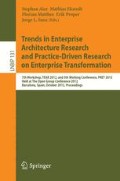Abstract
Enterprise architecture has become an established discipline for business and IT management. Architecture models constitute the core of the approach and serve the purpose of making the complexities of the real world understandable and manageable to humans. EA ideally aids the stakeholders of the enterprise to effectively plan, design, document, and communicate IT and business related issues, i.e. they provide decision support for the stakeholders. However, few initiatives explicitly state how one can analyze the EA models in order to aid decision-making. One approach that does focus on analysis is the Enterprise Architecture Modifiability Analysis Tool. This paper suggests changes to this tool and presents a case study in which these have been tested. The results indicate that the changes improved the tool. Also, based on the outcome of the case study further improvement possibilities are suggested.
Access this chapter
Tax calculation will be finalised at checkout
Purchases are for personal use only
Preview
Unable to display preview. Download preview PDF.
References
Ross, J., Weill, P., Robertson, D.: Enterprise architecture as strategy: Creating a foundation for business execution. Harvard Business Press (2006)
Department of Defense Architecture Framework Working Group: DoD Architecture Framework, version 1.5. Technical report, Department of Defense, USA (2007)
Zachman, J.A.: A framework for information systems architecture. IBM Systems Journal 26, 276–292 (1987)
The Open Group: The Open Group Architecture Framework (TOGAF) - version 9. The Open Group (2009)
Lankhorst, M.: Enterprise architecture at work: Modelling, communication and analysis. Springer-Verlag New York Inc. (2009)
Kurpjuweit, S., Winter, R.: Viewpoint-based meta model engineering. In: Enterprise Modelling and Information Systems Architectures, EMISA 2007 (2007)
Lagerström, R., Johnson, P., Ekstedt, M.: Architecture analysis of enterprise systems modifiability – a metamodel for software change cost estimation. Software Quality Journal 18, 437–468 (2010)
Lagerström, R., Johnson, P., Höök, D.: Architecture analysis of enterprise systems modifiability – models, analysis, and validation. Journal of Systems and Software 83(8), 1387–1403 (2010)
Boehm, B., Madachy, R., Steece, B., et al.: Software Cost Estimation with Cocomo II with Cdrom. Prentice Hall PTR (2000)
Bass, L., Clements, P., Kazman, R.: Software Architecture in Practice, 2nd edn. Addison-Wesley Longman Publishing Co., Inc., Boston (2003)
Oman, P., Hagemeister, J., Ash, D.: A definition and taxonomy for software maintainability. Technical report, Software Engineering Lab (1992)
IEEE Standards Board: IEEE standard glossary of software engineering technology. Technical report, The Institute of Electrical and Electronics Engineers (September 1990)
Halstead, M.: Elements of Software Science. Operating and programming systems series. Elsevier Science Inc. (1977)
Laird, L., Brennan, M.: Software measurement and estimation: a practical approach, vol. 2. Wiley-IEEE Computer Society Pr. (2006)
Henry, S., Kafura, D.: Software structure metrics based on information flow. IEEE Transactions on Software Engineering SE-7(5), 510–518 (1981)
Frappier, M., Matwin, S., Mili, A.: Software metrics for predicting maintainability. Software Metrics Study: Tech. Memo 2 (1994)
McCabe, T.: A complexity measure. IEEE Transactions on Software Engineering (4), 308–320 (1976)
Park, R.: Software size measurement: A framework for counting source statements. Technical report, DTIC Document (1992)
Curtis, B., Krasner, H., Iscoe, N.: A field study of the software design process for large systems. Communications of the ACM 31(11), 1268–1287 (1988)
Maraia, V.: The Build Master: Microsoft’s Software Configuration Management Best Practices. Addison-Wesley Professional (2005)
Jones, C.: Applied software measurement: assuring productivity and quality. McGraw-Hill, Inc. (1991)
Fenton, N., Melton, A.: Deriving structurally based software measures. Journal of Systems and Software 12(3), 177–187 (1990)
OMG: Object constraint language, version 2.2. Technical report, Object Management Group, OMG (February 2010)
Akehurst, D., Bordbar, B.: On Querying UML Data Models with OCL. In: Gogolla, M., Kobryn, C. (eds.) UML 2001. LNCS, vol. 2185, pp. 91–103. Springer, Heidelberg (2001)
Ullberg, J., Franke, U., Buschle, M., Johnson, P.: A tool for interoperability analysis of enterprise architecture models using Pi-OCL. In: Enterprise Interoperability IV, pp. 81–90 (2010)
IEEE: IEEE recommended practice for architectural description of software-intensive systems. Technical report, Technical Report IEEE Std 1471-2000. IEEE Computer Society (2000)
Cardoso, J., Mendling, J., Neumann, G., Reijers, H.: A Discourse on Complexity of Process Models. In: Eder, J., Dustdar, S. (eds.) BPM Workshops 2006. LNCS, vol. 4103, pp. 117–128. Springer, Heidelberg (2006)
Gruhn, V., Laue, R.: Complexity metrics for business process models. In: 9th International Conference on Business Information Systems (BIS 2006), Citeseer, vol. 85, pp. 1–12 (2006)
Närman, P., Buschle, M., Ekstedt, M.: An enterprise architecture framework for multi-attribute information systems analysis. Systems and Software Modeling (accepted to be published, 2012)
Author information
Authors and Affiliations
Editor information
Editors and Affiliations
Rights and permissions
Copyright information
© 2012 Springer-Verlag Berlin Heidelberg
About this paper
Cite this paper
Österlind, M., Lagerström, R., Rosell, P. (2012). Assessing Modifiability in Application Services Using Enterprise Architecture Models – A Case Study. In: Aier, S., Ekstedt, M., Matthes, F., Proper, E., Sanz, J.L. (eds) Trends in Enterprise Architecture Research and Practice-Driven Research on Enterprise Transformation. PRET TEAR 2012 2012. Lecture Notes in Business Information Processing, vol 131. Springer, Berlin, Heidelberg. https://doi.org/10.1007/978-3-642-34163-2_10
Download citation
DOI: https://doi.org/10.1007/978-3-642-34163-2_10
Publisher Name: Springer, Berlin, Heidelberg
Print ISBN: 978-3-642-34162-5
Online ISBN: 978-3-642-34163-2
eBook Packages: Computer ScienceComputer Science (R0)

